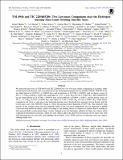TOI 694b and TIC 220568520b: Two Low-mass Companions near the Hydrogen-burning Mass Limit Orbiting Sun-like Stars
Author(s)
Unknown author
DownloadPublished version (2.187Mb)
Publisher Policy
Publisher Policy
Article is made available in accordance with the publisher's policy and may be subject to US copyright law. Please refer to the publisher's site for terms of use.
Terms of use
Metadata
Show full item recordAbstract
© 2020. The American Astronomical Society. All rights reserved.. We report the discovery of TOI 694 b and TIC 220568520 b, two low-mass stellar companions in eccentric orbits around metal-rich Sun-like stars, first detected by the Transiting Exoplanet Survey Satellite (TESS). TOI 694 b has an orbital period of 48.05131 ± 0.00019 days and eccentricity of 0.51946 ± 0.00081, and we derive a mass of 89.0 ± 5.3 MJup (0.0849 ± 0.0051 M⊙) and radius of 1.111 ± 0.017 RJup (0.1142 ± 0.0017 R⊙). TIC 220568520 b has an orbital period of 18.55769 ± 0.00039 days and eccentricity of 0.0964 ± 0.0032, and we derive a mass of 107.2 ± 5.2 MJup (0.1023 ± 0.0050 M⊙) and radius of 1.248 ± 0.018 RJup (0.1282 ± 0.0019 R⊙). Both binary companions lie close to and above the hydrogen-burning mass threshold that separates brown dwarfs and the lowest-mass stars, with TOI 694 b being 2σ above the canonical mass threshold of 0.075 M⊙. The relatively long periods of the systems mean that the magnetic fields of the low-mass companions are not expected to inhibit convection and inflate the radius, which according to one leading theory is common in similar objects residing in short-period tidally synchronized binary systems. Indeed we do not find radius inflation for these two objects when compared to theoretical isochrones. These two new objects add to the short but growing list of low-mass stars with well-measured masses and radii, and highlight the potential of the TESS mission for detecting such rare objects orbiting bright stars.
Date issued
2020-08Department
Massachusetts Institute of Technology. Department of Physics; MIT Kavli Institute for Astrophysics and Space Research; Massachusetts Institute of Technology. Department of Earth, Atmospheric, and Planetary Sciences; Massachusetts Institute of Technology. Department of Aeronautics and AstronauticsJournal
Astronomical Journal
Publisher
American Astronomical Society
ISSN
1538-3881